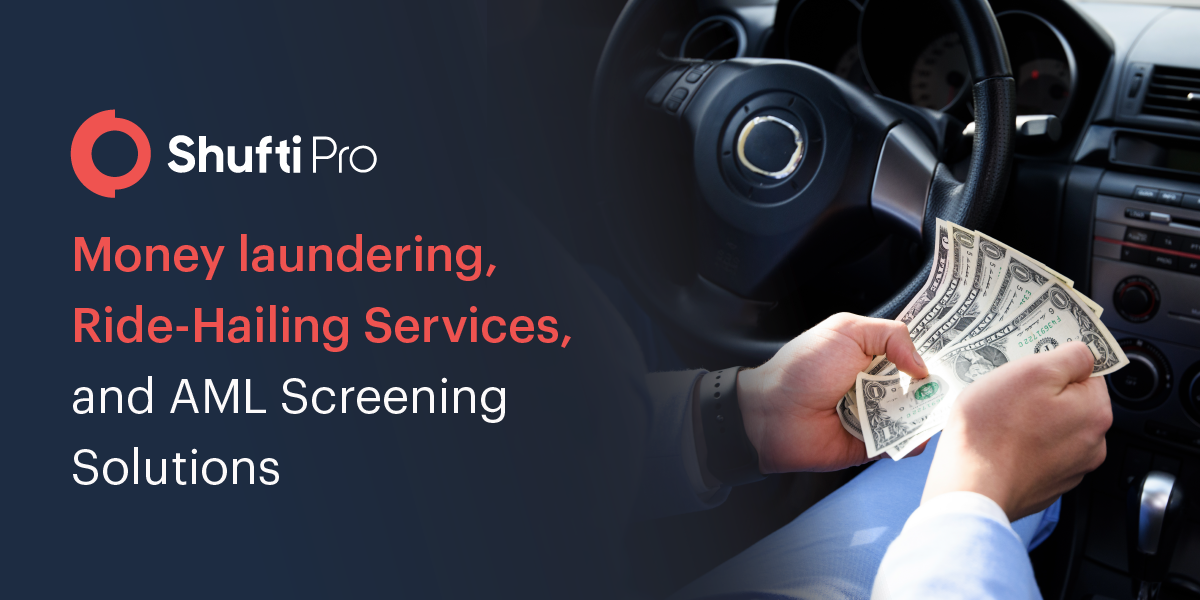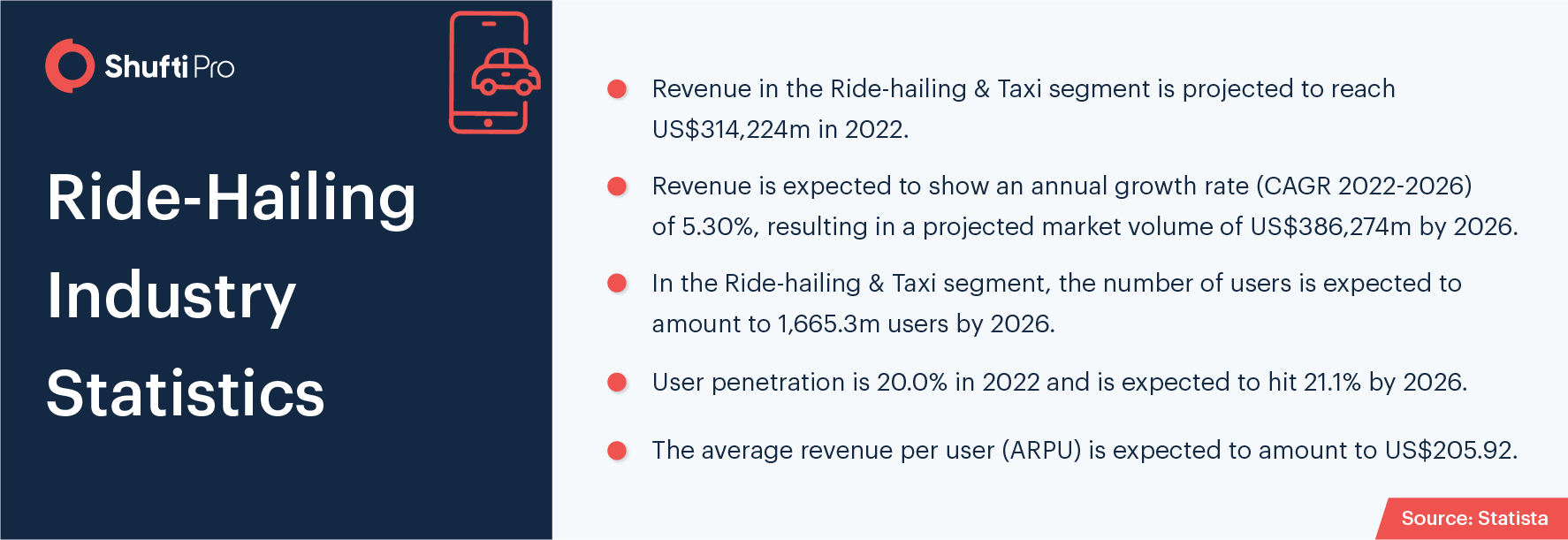Anti-Money Laundering (AML) Solution- Eradicating Money laundering and Securing Ride-Hailing Services

Due to the coronavirus global pandemic, the ride-hailing sector continue to grapple. As per new emerging norms and lockdowns across the world, there has been a significant increase in the demand for ride-hailing services. However, this is viable for companies, yet fraudsters are taking full advantage of defrauding businesses and laundering their illicit money. According to the United Nations Office on Drugs and Crime (UNODC), the estimated amount of money laundered globally in one year is 2–5% of global GDP, or $800 billion to $2 trillion in US dollars. This is why law enforcement bodies are increasingly asking ride-hailing companies to provide customers’ information.
In addition to this, financial watchdogs along with the governments of different jurisdictions have legislated anti-money laundering regulations with the objective of identifying and curbing the occurrence of money laundering. Thus, businesses are expected to comply with regulatory obligations.
Money Laundering and Ride-Sharing Services [2022 Outlook]
Fraudsters are using new emerging technologies to carry out money laundering activities, including onboarding illegitimate Uber riders, bogus Airbnb hosts, and cryptocurrency conversion experts from the dark web. However, the conventional means of money laundering are still prevailing. According to various news sources, for at least the past few years, money laundering has been diverted towards innovative methods based on “gig economies” applications like ride-hailing services to wash their illicit gains. The scheme works the same, to filter the dirty funds through automated systems, eventually making their way back to white money.
Other than cleaning the money, the motive behind money laundering is to legalize money earned through criminal activities and to remain away from the regulatory radar. However, digitization and the technological revolution have made fraudsters more sophisticated. For instance, criminals recruit drivers for ride-hailing services and pretend to take them on a ride. but criminals never show up and use the illegal money from the stolen credit card to pay for the trip. Then the driver wires a part of the payment for the trip back to criminals. The ride-hailing applications have payment gateways integrated into them, which makes it quite easy for fraudsters to use stolen credentials for paying the drivers.

Emerging Money Laundering Cases Through Ride-Hailing Industry
Taxi Driver Laundering Money for Organized Crime Gang Caught with £33,000
The law enforcement authorities caught an alleged driver who was assisting the organized crime group to launder more than EUR 33,000 in the trunk of the car. The individual was watched by the undercover investigation officers that were constantly watching since he was involved in the drug trafficking activities in Scotland.
Fiscal depute Marie Irvine told the court: “He is employed as a taxi driver and has no previous convictions. Over a number of months, intelligence was received that a Liverpool-based organized crime group was concerned about the supply of controlled drugs. Detectives were deployed as a surveillance team. A Ford Focus was observed on the A9 northbound and David Worley was identified as the driver.”
While concluding the investigation she said, the police found EUR 33,440 in cash from the suspect’s car. However, the driver was unaware that he was being used by the money launderer.
Uber Rides with Stolen Credit Cards
The Uber platform is also becoming a prime target of money launderers. The criminals are using the “ Gig Economy” to launder black money earned through criminal proceedings to avoid the detection of money laundering. According to the law enforcement authorities. During the money laundering procedure, criminals invest their money into fake rides that do not exist in reality, however, at the end of the day, the payment is returned to them by the drivers. To further explain in detail, the Uber drivers are recruited by the organized crime group, then they make it look fake that there is a rider in their vehicle. The money being laundered comes from the stolen credit cards that are paid to the riders, which appears to be legit, but it’s actually money laundering. However, dealing with drivers is a piece of cake. However, the drivers don’t feel guilty as they are highly paid in return for their services but still regret after learning about the legal regulatory sanctions and penalties for being involved in money laundering activities.
Furthermore, most of the money laundering cases through Uber happen in China. The technique used is called “Acupuncture” which caters to overseas transactions. In this scheme, the fraudsters collect the funds from the stolen credit cards through bogus rides and then send the money back to the overseas organized criminal groups. The criminals that receive the money are called “nurses”
In the acupuncture method, the driver, who deals with financial criminals, collects the money from the stolen credit card through the fake ride and then sends it back to the overseas criminals. The criminals who are sent overseas money in this process are called “nurses.”
Global Anti-Money Laundering Regime for the Ride-Hailing Businesses
Like other industries, the ride-hailing industry is facing heaps of challenges to sustain in the fast money economy. Yet the rising number of financial crimes, particularly money laundering is adversely impacting this sector. Thus to secure ride-hailing companies’ operation and customers’ data integrity, global financial regulatory authorities have come up with anti-money laundering regulations. AML compliance can assist businesses to identify the risk of money laundering, monitoring suspicious transactions, and performing background screening.
Following are some of the regulations that are all set to secure this industry;
The Financial Action Task Force
The Financial Action Task Force (FATF) is an inter-government body that is responsible for developing and promoting national as well as international standards to fight money laundering and terrorist financing. The regulatory body has come up with 40 Recommendations, that are legislated with mutual collaboration with its member nations. In addition to this, FATF keeps an eye over the countries and evaluates their anti-money laundering control frameworks, highlights the shortcomings, and helps them to enhance their AML systems. However, there are various sanctions and penalties for being non-compliant. Furthermore, according to the risk level, various lists are also developed by FATF, in which the nation having weak AML systems of curbing money laundering are placed, in accordance to the risk they possess.
The Financial Crimes Investigation Board
The financial crimes investigation board is constituted by the Republic of Turkey Ministry of Treasury And Finance. The board emerged with the objective of investigating and curbing the instance of money laundering and terrorist financing. FCIB is also contributing to creating a risk-free economy along with a secure society by making laws to completely eradicate money laundering activities from the country. In addition to this, the board also holds the power of auditing businesses and overseeing suspicious financial transactions.
Monetary Authority of Singapore
The Singapore monetary authority (MAS) is also considered the central bank of the country. It is responsible for regulating the financial sector along with the other businesses that cater to payment gateways. MAS also holds the right to develop and enforce standards to supervise financial firms. Other than this, the regulatory body has also legislated anti-money laundering and counter-terrorist financing to overcome financial crimes. Furthermore, strict penalties and hefty fines are also stated by the board in case the businesses are non-compliant with the obligations or fail to stop money laundering activities.
How Shufti Can Help
Nowadays, people are coming back to ride-hailing services. This means identifying the driver as well as riders are becoming more crucial than ever before, as various crimes like money laundering are done through this sector. Therefore, its regulatory obligations as well as the social responsibility for the businesses to incorporate identity verification and AML screening solutions into their security systems for legit customer onboarding.
Shufti’s state-of-the-art anti-money laundering service is an optimum solution for the ride-hailing industry as it can allow them to verify the riders and drivers against 1700+ watchlists in less than a second with 98.67% accuracy.
Want to know more about AML screening services for ridesharing companies?










